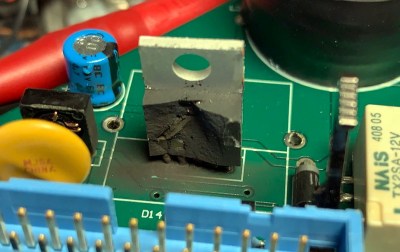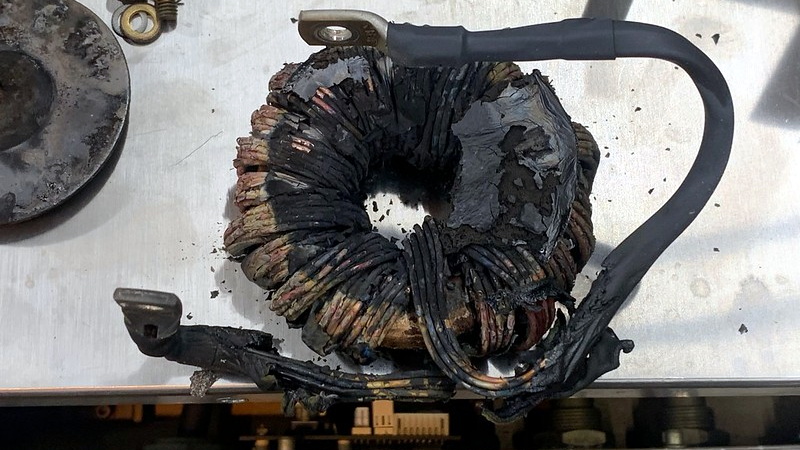A couple months back, [macona] got his hands on a 300 watt Rofin CO2 laser in an unknown condition. Unfortunately, its condition became all too known once he took a peek inside the case of the power supply and was confronted with some very toasty components. It was clear that the Magic Smoke had been released with a considerable bit of fury, the trick now was figuring out how to put it back in.
The most obvious casualty was an incinerated output inductor. His theory is that cracks in the ferrite toroid changed its magnetic properties, ultimately causing it to heat up during high frequency switching. With no active cooling, the insulation cooked off the wires and things started to really go south. Maybe. In any event, replacing it was a logical first step.

Unfortunately, Rofin is out of business and replacement parts weren’t available, so [macona] had to wind it himself with a self-sourced ferrite and magnet wire. Luckily, the power supply still had one good inductor that he could compare against. After replacing the coil and a few damaged ancillary wires and connectors, it seemed like the power supply was working again. But with the laser and necessary cooling lines connected, nothing happened.
A close look at the PCB in the laser head revealed that a LM2576HVT switching regulator had exploded rather violently. Replacing it wasn’t a problem, but why did it fail to begin with? A close examination showed the output trace was shorted to ground, and further investigation uncovered a blown SMBJ13A TVS diode. Installing the new components got the startup process to proceed a bit farther, but the laser still refused to fire. Resigned to hunting for bad parts with the aid of a microscope, he was able to determine a LM2574HVN voltage regulator in the RF supply had given up the ghost. [macona] replaced it, only for it to quickly heat up and fail.

Now this was getting ridiculous. He replaced the regulator again, and this time pointed his thermal camera at the board to try and see what else was getting hot. The culprit ended up being an obsolete DS8922AM dual differential line transceiver that he had to source from an overseas seller on eBay.
After the replacement IC arrived from the other side of the planet, [macona] installed it and was finally able to punch some flaming holes with his monster laser. Surely the only thing more satisfying than burning something with a laser is burning something with a laser you spent months laboriously repairing.
We love repairs at Hackaday, and judging by the analytics, so do you. One of this month’s most viewed posts is about a homeowner repairing their nearly new Husqvarna riding mower instead of sending it into get serviced under the warranty. Clearly there’s something about experiencing the troubleshooting and repair process vicariously, with our one’s own hardware safely tucked away at home, that resonates with the technical crowd.
















LMLM2576HVT ? I think this one got an LM too much ;D
He should have gone for a LMLMLMLM2576HVT to add three more layers of durability.
Robin may not be around anymore but are now called Luxinar based Hull. I’m sure they would be happy to support you with aftermarket spares.
Luxinar wants nothing to do with these lasers. They dont support them at all.
Looks like he turned a pile of ashes into a fine piece of furniture, nice work.
I got lucky. Doing this stuff with no schematics outside of an overall wiring diagram is a pain.
Nice job!!
Yes, indeed you were.. Don’t think you’ll ever get crusted wires that point to where they were originally going and components exactly as they failed from any other reader of this blog..
The previous owner deciding to sell As-is its pretty awesome. And right away too!
It’s an interesting thank you for putting it out on the internet.
Interesting *read*
No problem. With how little info is out there on these it’s a good way to archive what I went through in case anyone else has similar issues.
Awesome job ! I believe in repair not replace. Now that the laser is firing…. I have a neighbor I would love to put a giant Jiffy Pop in his living room and aim that bad boy at it. (Any resemblance to a movie is just a coincidence)
… here, you’ll need my bunny slippers.
You provide the jet and tracking system.
https://www.youtube.com/watch?v=PSc9BsQCB3E&t=34s
Surely the only thing more satisfying than burning something with a laser is burning something with a laser that is not the laser itself.
Or yourself!
B^)
And dont call me Shirley :)
i deal with these on a daily basis Rofin was purchased by Coherent but they still support all the old Rofin products.
Thank you!
It’s a Scx30 and it’s made in Hull. Luxinar is a brand now it has to be sold when Coherent purchased Rofin
Coherent had to let go of Rofin because of an anti-trust ruling so Luxinar got them like mentioned below. Luxinar will not support the old lasers in the slightest. Looks like they bought them just for the tech.
Since you cannot see the laser beam, you have no idea what it might reflect off of, which would pose a serious danger. I remember seeing a 1000W CO2 laser demonstrated and every person in the room had to wear polycarbonate goggles fo protection.
If you *can* see what the beam reflects off, it’s too late. ;-)
It’s because you were on demonstration. I work on up to 8kW Co2 lasers and never wear a goggles.
CO2 is a different beast than visible and NIR lasers. CO2 cant penetrate the eye in any way, it is totally absorbed. Its basically like a beam of heat. I used to work on lasers up to 4.4kw, they are way safer to work on than the equivalent in YAG or a fiber laser.
Hello! Long shot here… do you know why my scx30 laser head only works intermittently? Everything else functions fine and the LEDs all work…